| Diese Seite auf Deutsch! |
|
ChitonsPolyplacophora Gray, 1821 |
(Synonyms: Loricata Schumacher, 1817; Polyplaxiphora Ducrotay-Blainville, 1819; Placophora Ihering, 1876)
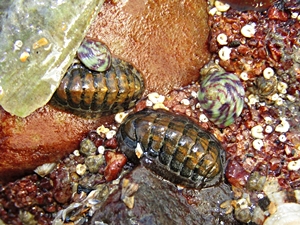 Two grey chitons (Lepidochitona cinerea): Pontevedra, Gali- cia, Spain. Photo: Jonatan Antunez (iNaturalist). |
|
 |
||||||||||||||||||||||||||||||||
| Number of species in Mollusca, displayed by classes, including percentage. Sources: WoRMS: MolluscaBase eds. (2025): Mollusca LINNAEUS, 1758. | |||||||||||||||||||||||||||||||||
The grey chiton (Lepidochitona cinerea) on the other hand, about 2 cm in size, is found on the coasts of the western Mediterranean, the eastern North Atlantic and the North Sea, from the English Channel as far as western Norway and the western Baltic Sea (to the island of Rügen). In its distribution area the grey chiton usually is the most frequent chiton species.
The chitons live on hard ground (stones, mussel shells, wood), where they graze algae, usually on flat sea coasts (usually below the low water line and in the sublittoral zone, but also in the littoral zone, where they can be found in tidepools during low tide.
![]() Ian Frank Smith:
Lepidochitona cinerea, Identification and Biology. (Link).
Ian Frank Smith:
Lepidochitona cinerea, Identification and Biology. (Link).
In German, chitons are called Käferschnecken, but they are, of course, neither beetles nor snails. But, beetles being the best armoured of all insects, chitons might also be imagined as armoured molluscs, compared to their relatives in the Solenogastres and Caudofoveata, who lack shell plates and only are protected by calcareous spikes. In English, chitons are also referred to as coat-of-mail shells. Like a medieval knight's armoured gauntlet, chitons are protected by several shell plates, so the meaning of the expression is clear.
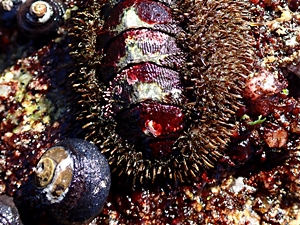 Girdle and shell plates of a chiton (Mopalia muscosa): Monte- rey County, California, USA. Photo: Max Erickson (iNaturalist). |
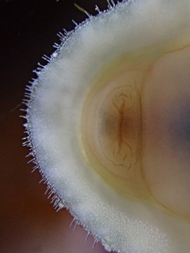 Head of a chiton (Lepidochitona cine- rea): La Rocque, Jersey, Great Britain. Photo: Chris Isaacs (iNaturalist). |
Light grey: Girdle; Dark grey: Shell plates; Light pink: Mantle; Dark pink: Foot; Red: Gills. Source: Livingstone, Biodidac. Adaptation: R. Nordsieck. |
As in other molluscs, the protective dorsal epidermis is called the mantle. Unlike the more advanced molluscs, however, chitons lack a mantle cavity. Instead, between the girdle on the outside and the foot lies the mantle groove, which runs in a U-shape around the posterior part of the body. Within the mantle groove are arranged numerous gills in series: the typical molluscan ctenidia, or comb gills.
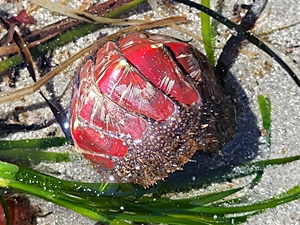 Curled-up chiton (Mopalia lignosa): British Columbia, Canada. Photo: Marcie Callewaert John/a> (iNaturalist). |
Not only the shell of chitons is hard. Like snails, they also possess a radula with which they scrape food from the substrate, unless, like Placiphorella rufa (see below), they belong to the rare carnivorous members of the class. The chiton Chaetopleura apiculata, which occurs in the Gulf of Mexico, the north-western Atlantic, as well as the eastern Pacific and off Colombia, has the hardest known teeth in nature. Chaetopleura often scrapes rocks particularly intensively in order to reach food hidden in cracks and crevices.
Materials science institutes are studying how this extremely hard, yet, interestingly, not brittle, material is formed through the interaction of organic and inorganic components, and how it might possibly be replicated.
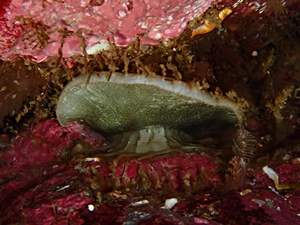 Anterior view of the predatory chiton Placiphorella rufa: Sitka, Alaska, USA. Bild: Paul Norwood (iNaturalist) |
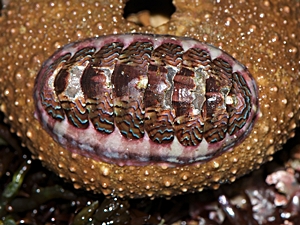 Chiton (Tonicella lineata) on the skeleton of a sea urchin. Photo: Jerry Kirkhart (Source). |
In chitons there are two types of shell eyes: Intrapigmentary shell eyes are situated within the aesthetes and consist of a small pigment cup with sensory cells, covered by a lens. Extrapigmentary shell eyes, on the other hand, have the pigment cup located outside the aesthetes in the outer layer (tegumentum), while the tip of the aesthete is transformed into a lens.
These shell eyes enable the chiton to distinguish between light and shadow across its back. In this way, the animal can perceive approaching threats without having to lift the protective girdle from the substrate. In Acanthopleura species, several thousand shell eyes may be distributed across the dorsal surface.
![]() Jan Osterkamp:
Käferschnecken balancieren Panzerung und Aufklärung.
a href="https://www.spektrum.de" target="_blank">Spektrum.de (20.11.2015).
Jan Osterkamp:
Käferschnecken balancieren Panzerung und Aufklärung.
a href="https://www.spektrum.de" target="_blank">Spektrum.de (20.11.2015).
Chitons, for the most part, are dioecious, having two diferent sexes. The gonads, originally paired, usually are grown together as a single unpaired organ with the exiting ducts leading into the pallial groove. Fertlization takes place openly in the water. The Development of the juveniles takes place via a Trochophora-like larval stadium, which, after a metamorphosis, changes into a juvenile chiton, resembling the adult specimens.
![]() Cryptochiton stelleri/em> during spawning (Photos: Robin Gwen Agarwal,
iNaturalist/a>)).
Cryptochiton stelleri/em> during spawning (Photos: Robin Gwen Agarwal,
iNaturalist/a>)).
The class Polyplacophora Gray/span>,, 1821(Chitons) is divided into three extant orders, altogether comprising 19 families with about 1,000 extant species:
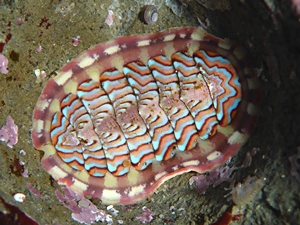 Tonicella lokii: San Mateo, Kalifornien, USA. Bild: Alison Young (iNaturalist). |
|
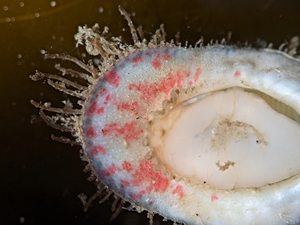 Unterseite von Placiphorella velata: San Luis Obispo, Kalifor- nien, USA. Bild: Alex Heyman (iNaturalist). |
![]() Subclass: Neoloricata Bergenhayn, 1955
Subclass: Neoloricata Bergenhayn, 1955
![]()
![]() Order: Callochitonida Giribet & Edgecombe, 2020
Order: Callochitonida Giribet & Edgecombe, 2020
![]()
![]() Family: Callochitonidae Plate, 1901
Family: Callochitonidae Plate, 1901
![]()
![]() Order: Chitonida Thiele, 1909
Order: Chitonida Thiele, 1909
![]()
![]() Suborder: Acanthochitonina Bergenhayn, 1930
Suborder: Acanthochitonina Bergenhayn, 1930
![]()
![]() Superfamily: Cryptoplacoidea H. Adams & A. Adams, 1858
Superfamily: Cryptoplacoidea H. Adams & A. Adams, 1858
![]()
![]() Family: Acanthochitonidae Simroth, 1894 (1881): z.B.
Cryptochiton stelleri (Middendorff, 1847).
Family: Acanthochitonidae Simroth, 1894 (1881): z.B.
Cryptochiton stelleri (Middendorff, 1847).
![]()
![]() Family: Choriplacidae Ashby, 1928
Family: Choriplacidae Ashby, 1928
![]()
![]() Family: Cryptoplacidae H. Adams & A. Adams, 1858
Family: Cryptoplacidae H. Adams & A. Adams, 1858
![]()
![]() Family: Hemiarthridae Sirenko, 1997
Family: Hemiarthridae Sirenko, 1997
![]()
![]() Superfamily: Mopalioidea Dall, 1889
Superfamily: Mopalioidea Dall, 1889
![]()
![]() Family: Mopaliidae Dall, 1889: z.B. Placiphorella rufa S. S. Berry, 1917 und
Mopalia muscosa (A. Gould, 1846).
Family: Mopaliidae Dall, 1889: z.B. Placiphorella rufa S. S. Berry, 1917 und
Mopalia muscosa (A. Gould, 1846).
![]()
![]() Family: Schizoplacidae Bergenhayn, 1955
Family: Schizoplacidae Bergenhayn, 1955
![]()
![]() Family: Tonicellidae Simroth, 1894: z.B.
Tonicella lineata (W. Wood, 1815) und
Lepidochitona cinerea (Linnaeus, 1767).
Family: Tonicellidae Simroth, 1894: z.B.
Tonicella lineata (W. Wood, 1815) und
Lepidochitona cinerea (Linnaeus, 1767).
![]()
![]() Suborder: Chitonina Thiele, 1909
Suborder: Chitonina Thiele, 1909
![]()
![]() Superfamily: Chitonoidea Rafinesque, 1815
Superfamily: Chitonoidea Rafinesque, 1815
![]()
![]() Family: Callistoplacidae Pilsbry, 1893
Family: Callistoplacidae Pilsbry, 1893
![]()
![]() Family: Chaetopleuridae Plate, 1899
Family: Chaetopleuridae Plate, 1899
![]()
![]() Family: Chitonidae Rafinesque, 1815
Family: Chitonidae Rafinesque, 1815
![]()
![]() Family: Ischnochitonidae Dall, 1889
Family: Ischnochitonidae Dall, 1889
![]()
![]() Family: Loricidae Iredale & Hull, 1923
Family: Loricidae Iredale & Hull, 1923
![]()
![]() Superfamily: Schizochitonoidea Dall, 1889
Superfamily: Schizochitonoidea Dall, 1889
![]()
![]() Order: Lepidopleurida Thiele, 1909
Order: Lepidopleurida Thiele, 1909
![]()
![]() Suborder: Lepidopleurina Thiele, 1909
Suborder: Lepidopleurina Thiele, 1909
![]()
![]() Family: Abyssochitonidae Dell'Angelo & Palazzi, 1989
Family: Abyssochitonidae Dell'Angelo & Palazzi, 1989
![]()
![]() Family: Hanleyidae Bergenhayn, 1955
Family: Hanleyidae Bergenhayn, 1955
![]()
![]() Family: Leptochitonidae Dall, 1889
Family: Leptochitonidae Dall, 1889
![]()
![]() Family: Nierstraszellidae Sirenko, 1992
Family: Nierstraszellidae Sirenko, 1992
![]()
![]() Family: Protochitonidae Ashby/span>,, 1925
Family: Protochitonidae Ashby/span>,, 1925
Latest Change: !--webbot bot="Timestamp" S-Type="EDITED" S-Format="%d.%m.%Y" --> (Robert Nordsieck).